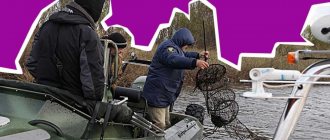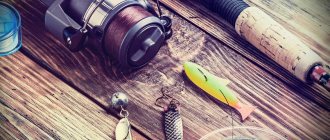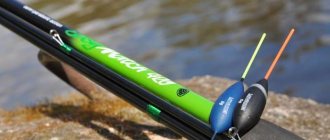A boat on the water must have supplies on board
Each small vessel, when going out on the water, must have on board mandatory equipment to ensure navigation safety, approved by the State Inspectorate of Inspection.
There must be a number of life jackets in the boat according to the number of people on board.
Extract from the Temporary Rules for the classification and technical requirements for pleasure and other vessels supervised by the State Inspectorate for Small Vessels of the Russian Federation, approved by order of the Main Directorate of GIMS of Russia dated June 28, 2001 No. 42.
6.3.4.3. The supply of supervised vessels, in general, must correspond to the table. 6.3.4.4. All vessels, regardless of the navigation area, except for rowing boats (boat rental stations), must have red light flares, and on vessels operating in the coastal part of the seas and on large lakes, additional distress flares must be parachute.
6.3.4.5. Personal life-saving appliances on board the ship must be painted orange with the ship's side number (name) printed on them and meet the requirements of the standards.
6.3.4.6. Rowing boats at boat rental stations located on non-navigable waters are allowed to have one lifebuoy.
Inspection for a boat with a motor 2021
GIMS inspects the boat and motor on land. At the same time, the technical documentation for the vessel is checked, the capacity of the vessel, mandatory conditions, norms and technical requirements for its carrying capacity and passenger capacity, permissible power and number of engines (outboard motors) are established... minimum freeboard height, wave height at which the vessel can sail, equipment rescue and fire-fighting equipment, signal lights, navigation and other equipment. An initial technical inspection report is drawn up, the data from which is entered into the ship's ticket, and a stamp is placed on the completion of maintenance.
If the boat is new, but without a certificate, or the parameters stated in the technical documentation (passport) for the vessel do not correspond to the parameters of the vessel submitted for technical examination, additional tests are carried out on the water. This category includes such violations as unjustified lack of technical examination and incorrect application of side numbers. Within the same amounts, driving a small vessel without registration, lack of a navigation license, and re-equipping a boat or boat without obtaining permission from the supervisory authorities of the State Inspectorate for Emergency Situations of the Ministry of Emergency Situations are punishable.
Also, a fine of 500 to 1000 rubles is imposed on boatmasters who carry on board a number of passengers exceeding the established norm.
It is also worth noting here such offenses as ignoring the boundaries of water areas of permitted navigation and areas closed to navigation.
What should be in a boat when on a body of water
Table of supplies for supervised vessels
6.3.4.7. All ships, regardless of class, must be equipped with a rope of appropriate length, caliber and material to ensure the safety of mooring and towing ships in navigation areas, and ships of classes 1-3 must have a lifeline of at least 16 meters in length
6.3.4.8. Vessels with sailing rigs must be equipped with safety belts (devices that replace them) according to the number of crew members involved in servicing the sails.
6.3.4.9. Each ship of classes 1-4 must have a complete first aid kit.
6.3.4.10. Vessels of 1-3 classes must be equipped with an electric lamp suitable for signaling, and vessels of 1 class, in addition, must have a searchlight (search light).
6.3.4.11. All motor and sailing vessels must have a set of tools for repairs, which must include a hacksaw, and sailing vessels, in addition, must have a means for cutting rigging in extreme conditions.
6.3.4.12. Each vessel, except for jet skis, must have a manual dewatering device (bucket, scoop, etc.) and a release hook (oar on rowing boats). Motor vessels and vessels with sailing equipment, where this is provided for by the technical specifications, must have at least 2 oars for use as a backup propulsion device.
6.3.4.13. Vessels of 1-2 classes must have a course indicator (compass), a lot, anemometer, barometer, binoculars and a map of the navigation area, and vessels of 1 class, in addition, must be equipped with radiotelephone communications and radar reflectors.
6.3.4.14. All vessels, regardless of the category of navigation, except for rowing boats of boat (rental) stations and jet skis, must be equipped with red light flares in an amount of at least 3 pieces, and vessels of 1-3 classes must additionally be equipped with red light distress signal flares.
6.3.4.15. Storage conditions must be provided on ships to ensure the safety and readiness for action of the pyrotechnics on board.
6.3.4.16. The basis for assessing the technical condition as “fit” is the presence and serviceability of supplies, their compliance with the above requirements.
6.3.4.17. The basis for assessing the technical condition as “limitedly suitable” is the discrepancy between the nomenclature of supplies and the category of the pool that determines the class of the vessel, while the ship is assigned the class to which the available supplies on the ship correspond.
6.3.4.18. The basis for assessing the technical condition as “prohibited for operation” is the absence of the above-mentioned supplies on the ship or their malfunction.
Supplies missing from the Table of Contents are provided for by the Temporary Rules in blue font.
What you need to have in the boat - mandatory equipment
In 2021, rowing and motor boats still require certain equipment as before. The corresponding requirements are specified in mandatory documents used by GIMS employees. In particular, this is a letter from the UGIMS of Russia dated January 27, 2011 No. 29/2-3-62. It states that you must have a boat that can accommodate up to 3 people, unless it has a rigid hull. Mandatory types of equipment in this case include:
- Rescue line (length from 15 m) or lifebuoy with line (length from 15 m);
- A device for rowing, for example, it can be a regular oar - 2 pcs.;
- A device for giving sound signals, you can use a whistle from a life jacket;
- Life jacket - it must be available in a quantity corresponding to the number of people on board.
If the boat can accommodate more than 3 people, and also if it has a rigid hull, in addition to the above equipment, it must be equipped with:
- Using a scoop or hand pump;
- Flashlight with white light, 2 red flares used for distress signals. (You may not have these devices if the vessel is moving on a small body of water, and the boat does not move more than 2 km from the shore).
What should be in a boat up to 6 m long? Everything listed above must be present on board and, not in all regions, but it may be mandatory - this is a gaff or a release hook.
Important! All small vessels must have navigation lights at night. Otherwise, you cannot go out on the water from sunset to sunrise.
We invite you to watch a video about the development of our specialists, which allows you to legally use small vessels in the dark.
Is it required to have a fire extinguisher on a boat up to 6m long? Yes, if the boat has devices that are used for cooking or have a heating function, and also if the boat has a boat motor. By the way, today you can often find lovers of dishes freshly prepared on board an inflatable boat. They will have to show the employees a fire extinguisher when checking the GIMS. Otherwise, they will face punishment.
Small vessels: registration, technical inspection and operation
Orders of the Minister of Emergency Situations (reg. No., dated February 6, 2018 ) approved the rules for registration, technical inspection of small vessels, as well as the use of them and bases (structures) for their moorings.
Small vessels that are subject to the requirements of approved documents include:
- self-propelled vessels with a main engine with a power of less than 55 kW (75 hp) and a permissible passenger capacity of no more than 12 people;
- vessels with outboard motors, regardless of their power and number;
- jet ski (jet ski);
- non-self-propelled vessel with a carrying capacity of no more than 80 tons;
- inflatable non-motorized rowing boats.
Registration of small vessels
Registration of all types of small vessels is carried out by making appropriate notes in the registration book (hereinafter referred to as the ship book). Motorized and rowing vessels are registered in separate books and are issued a small boat ticket.
Driving small vessels is permitted to persons who have a certificate for the right to operate small vessels. The operation of unregistered small boats is prohibited.
A small boat, regardless of its technical condition, must be registered within 1 month from the date of purchase. Registration is carried out in the relevant territorial departments of the Ministry of Emergency Situations at the request of interested parties. During registration, a small boat is assigned a side number, which must be applied to the side of the vessel on both sides with indelible contrasting paint.
If the owner changes, its address changes, or the vessel is re-equipped, it is subject to re-registration with the assignment of a new hull number and the issuance of a new ticket, as well as making a corresponding entry in the ship's book.
If it is impossible to restore or is unsuitable for operation, the small vessel is deregistered.
For registration (re-registration) of small vessels, a fee is paid in the following amounts:
| For registration (re-registration) of a small boat with an outboard and stationary engine and issuance of a small boat ticket | 20% |
| For registration (re-registration) of rowing and sailing vessels of all types, including inflatable types | 10% |
| For issuing a duplicate ticket for a small boat | 10% |
The funds paid for the registration (re-registration) of small vessels go to the extra-budgetary fund of the Ministry of Emergency Situations.
Inspection of small vessels
A registered vessel must undergo an annual roadworthiness inspection and be stamped accordingly. The technical inspection is carried out by territorial chief inspectors of the Inspectorate for Small Vessels of the Ministry of Emergency Situations. The operation of small vessels that do not meet safety requirements is prohibited.
Technical supervision of small vessels includes:
- preliminary technical inspection (before registration), during which the basic parameters of the vessel are checked: carrying capacity, passenger capacity, engine number, permitted power, permitted sail area, place of navigation, permissible wave height, availability of life-saving and fire-fighting equipment, signal aids and navigation instruments, side height etc. Based on the results of the technical inspection, a report is drawn up in 2 copies, one of which is handed over to the owner of the vessel.
- annual technical inspection , which is carried out from March 1 to June 30 at specially equipped points. During its course, the absence of changes in the main elements, the technical condition and the availability of appropriate instruments and means are checked. Using special means and methods, the condition of the material of the corresponding vessel (rubber material, aluminum, plastic, wood, etc.), the strength of the hull, its paint and varnish coating, water resistance, the condition of towing devices and other parameters are checked. If malfunctions or other deficiencies that impede operation are identified, the vessel is recognized as unsuitable, and a corresponding report is drawn up, where all the deficiencies are indicated.
- special technical inspection - carried out after repair, re-equipment or accident of the vessel.
The following fees apply for technical inspection:
| Inspection of small boats with outboard and inboard engines | 20% |
| Inspection of rowing and sailing vessels of all types, including inflatable types | 10% |
| Inspection of a small vessel after repair, re-equipment, after an accident | 20% |
Money paid for the technical inspection of small vessels goes to the extra-budgetary fund of the Ministry of Emergency Situations.
Use of small boats
For parking of small vessels on the water and adjacent coastal areas, specially equipped places are created - bases (structures). In water basins, the operation of small vessels is permitted from the moment of opening until the moment of closure of navigation after the end of the mudflow and flood period. The speed of small vessels should not exceed 30 km/h within the boundaries of populated areas, stops, ports, and in areas of beaches and public recreation - no more than 10 km/h.
The document also establishes requirements for the placement of parking lots for small vessels in relation to populated areas, hydraulic structures, places of mass recreation for people, as well as the procedure for holding public events and competitions with the participation of small vessels, including safety rules for the operation of small vessels.
The documents are published in the National Legislation Database in the state language and come into force on March 8, 2018.
The full text of these documents, with comments and links to other acts of legislation related to them can be found in the information retrieval system "".
Anvar Irkakhodzhaev.









